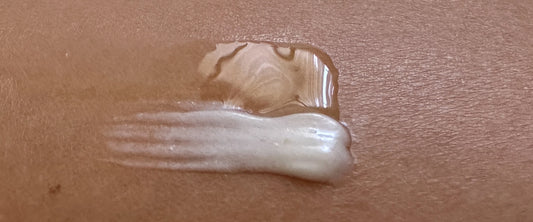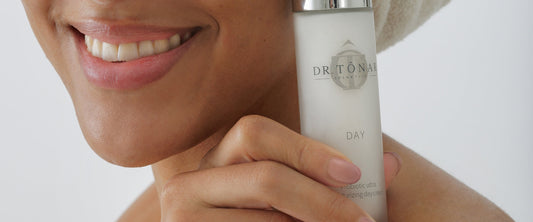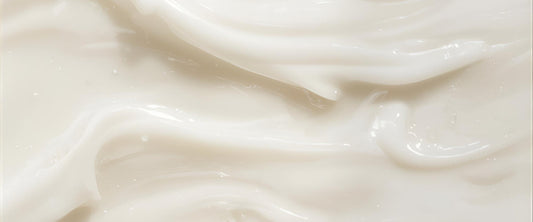Our skin also reflects diversity. There are different skin types that differ in their properties and needs. But the right care makes every skin type shine. Read here about the different skin types, how you can determine your own skin type and how to best care for it.

The skin types
Healthy skin is divided into four types: normal skin, dry skin, oily skin and combination skin. Skin type is determined by genetic factors. However, individual skin condition varies depending on the various internal and external factors that affect the skin.
Skin type: Normal skin
The term "normal" is generally used to describe a balanced complexion. Normal skin is therefore neither too oily nor too dry. The T-zone (forehead, nose and chin) can be slightly oily in normal skin types. Overall, however, the sebum and moisture levels are balanced and the skin is neither too oily nor too dry. The skin feels velvety and soft. However, as we age, even normal skin can experience age-related dryness.

The normal skin type is characterized by fine pores, good circulation and an even, fresh complexion. The skin is not prone to blemishes and is insensitive.
Skin type: Dry skin
The dry skin type is characterized by the fact that less sebum is produced than normal skin. The result is tight skin that feels rough and looks pale. The water content in the deeper layers of the skin and sweating are crucial for skin moisture. The skin continuously loses moisture, particularly through sweating and transepidermal water loss (TEWL). Dry skin lacks lipids that prevent moisture loss and form a protective film against external influences. It also lacks natural moisturizing factors such as urea, amino acids and lactic acid. This deficiency can impair the skin's barrier function, which subsequently leads to a disturbed moisture balance. In addition, significantly more women than men are affected by dry skin. Women have smaller sebaceous glands than men and produce about a third less protective skin fat.

The dry skin type is slightly flaky in places and can be visibly rough and spotty. A feeling of tightness and possibly itching are also signs of a dry skin type.
Skin type: Oily skin
Oily skin produces more sebum. Excessive sebum production leads to shiny skin, enlarged pores, spots and blemishes. There are various triggers for excessive sebum production: genetic factors, hormonal changes and disorders, medication, stress and cosmetics that clog the pores.

The oily skin type usually has enlarged and clearly visible pores and therefore a shiny complexion. Comedones (blackheads), skin blemishes and various forms of acne are also typical for this skin type.
Skin type: combination skin
The term "combination skin", as the name suggests, is used for a skin type with mixed characteristics. With combination skin, the skin in the T-zone and on the cheeks has different characteristics. The extent of the T-zone can vary greatly - from a very narrow strip to an extensive area. The oilier areas are caused by excessive sebum production and the resulting lipid deficiency.

An oily T-zone and drier cheeks usually indicate combination skin. Enlarged pores and blemishes in the T-zone can also occur with this skin type. The skin on the cheeks is usually normal to dry.
Determine your own skin type
Knowing your own skin type is the key to effective skin care. Only those who know the needs of their skin can choose the right products and develop an individual care routine. The wrong products can make skin problems worse or trigger new ones. You can determine your own skin type with a cleansing and blotting sheet test.
Cleaning test
Wash your face thoroughly and pat it dry gently with a towel. After washing, do not apply any skin care products, but leave your skin uncovered for 30 minutes. After the waiting period, observe how your skin feels. Pay attention to how your cheeks, chin, nose and forehead feel, especially when you smile or make other facial expressions. Also try squeezing the skin between two fingers. If the skin wrinkles easily when squeezed, this indicates dry or combination skin. Oily skin, on the other hand, feels soft in this test.
Blotting sheet test
The blotting sheet test can be particularly informative if you have oily or dry skin. The test is quick to do. Gently dab the different parts of your face with a thin cloth, such as a layer of tissue or a blotting sheet from the drugstore. Then hold the cloth up to the light to see how much oil is visible. Little or no oil on the blotting sheet indicates dry skin. If you have normal or combination skin, the cloth will be oily in the forehead and nose area. An oily skin type can be identified by a cloth soaked in oil.

The right care for every skin type
All Dr. Tonar Cosmetics products are formulated to restore skin health by supporting the barrier function and providing the skin with the moisture it needs to make it radiant again. Discover the right skincare routine for your skin type here:
Normal skin
Dry skin
Oily skin
Combination skin








